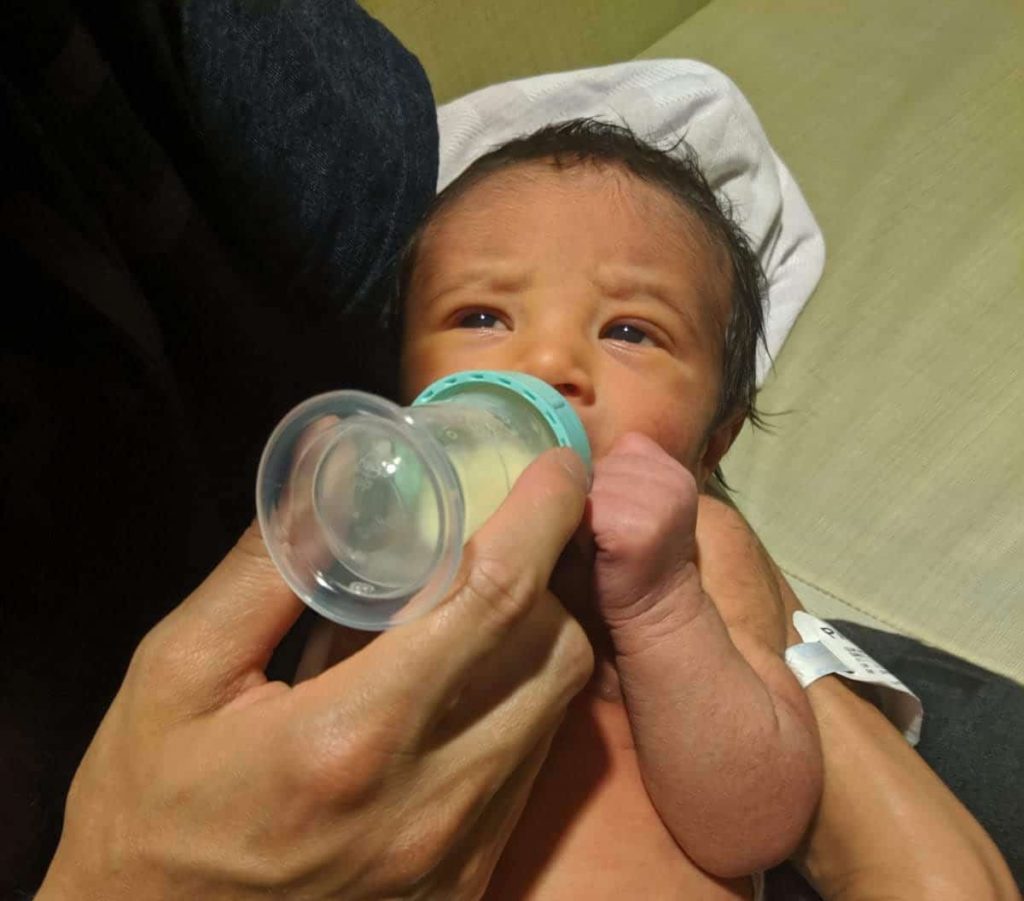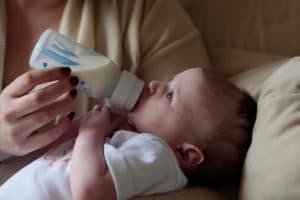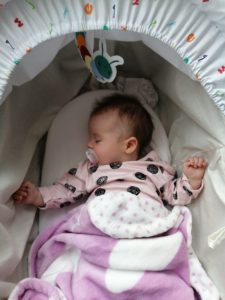Do you ever ask yourself the question, Breastfeeding vs. Formula Feeding: which is right for you? We always hear the push to breastfeed our babies, along with the multitude of benefits that come with it. If you’re able to produce the right amount of milk, get your baby to latch correctly and find it manageable, then this is the way to go, in my opinion.
Often times, it just doesn’t work for mom or baby and that is perfectly all right. Formula nourishes your baby just as well and no mom should feel any guilt or shame in choosing one versus the other.
As a mom who has tried both, and gone through the challenges, I wanted to share some of my tips in the hopes I can make it easier for other mom’s. I’ll go through the pros and cons of both breastfeeding and formula feeding as well as everything you need to know about pumping and weaning! I’ll help answer the question, Breastfeeding vs. Formula Feeding: which is right for you?
*When you click on links to various merchants on this site and make a purchase, this can result in this site earning a commission. Please read my Privacy Policy for more information
Breastfeeding Basics
With my eldest, Jahan, I exclusively breastfed him. While I tried formula, he never had a sip of it, mainly because he refused to bottle feed, despite me trying. So, he was tied to me and I couldn’t really go out unless it was during his bedtime. This was definitely one of the downsides. I couldn’t detach myself from him much, and should have incorporated bottle feeding earlier. Even with pumped milk, he just wasn’t a fan of using the bottle.
It will be hard at first – keep at it
If you are able to breastfeed, give it a few weeks before giving up. It will definitely be a challenge. There are so many things you need to tackle. Everything from trying to find the best position that works for both you and baby, getting the proper latch and figuring out feeding times. There is also getting through the cluster feeds – when you feel like you are literally breastfeeding your child the entire day and night.
It will be painful at first. You may get bitten, there may be pain if you are unable to find the correct latch and your nipples may bleed, chap and just be sore. This is normal and all part of the process! If you can stick to it and get through it, it becomes much easier and second nature after those first few weeks.
Get help from a lactation consultant early
I remember when I was in the hospital with Jahan, right after giving birth to him, he was apparently better than average at breastfeeding. I wasn’t able to be seen by a lactation consultant during my initial stay as the consultants were busy with other mom’s who needed their services more. However, you are able to book appointments with them so do so before leaving the hospital.
The Initial Visit
During this visit, the consultants will help you with your latch, show you different positions and weigh baby before and after each feed so you can determine how much milk baby is getting from you. This is super helpful so you can gauge how much your child is drinking. They can advise if you need to pump to top-up by bottle feeding after each breastfeed. They will give you instructions on how often to pump, for how long, and how much to top up, if needed. I had to pump for Jahan, I’ll get to the details on that later in this blog post. These meetings are essential if you plan to breastfeed, or at least try to.
Additional Visits
At the end of each visit, the consultant will decide if you need to come back for more, and when. They will gauge based on, how much baby is taking, if baby is comfortable with the latch, and by baby’s weight. If they feel help is still needed they will continue to see you until you’re all set!
Purchase some breastfeeding essentials
- Prior to having your baby, purchase a breastfeeding shawl. This will come in handy at the hospital and with the lactation consultants if you want to cover up. It will definitely be needed when you go for outings later on, if you prefer privacy and want to cover up
- I loved my breastfeeding pillow. It will help get you and your baby comfortable which is essential when you first start with breastfeeding. Not using one or trying to prop yourself up with pillows, didn’t do the trick for me when I was just starting out.
- It’s also handy to purchase a pump – I got the Medala automatic pump. It was expensive but definitely worth it! I pumped often, for milk supply and for when I was going out I could pump and store. Once you start weaning, having a pump is useful as well. Manual pumps are pretty slow and it’s a pain sitting through that
- Bottles, pumping storage bags (for milk storage), a pumping bra (so you can have your hands free to do something else while pumping) and bottle brushes, drying rack and a sterilization system were also must haves
To shop my recommendations of the best breastfeeding essentials, please click on any of the below images.
Find a position that works for you
There are so many different breastfeeding positions you can try. Personally, I found the football hold worked with Jahan at the beginning, then we switched to the cradle position. I couldn’t really get the other positions to work for us. For Rivaan, my youngest, the cradle was the only position that worked for us. Experiment with a few, to see which feels comfortable and which one gives the best latch. The lactation consultants and the breastfeeding pillow will definitely come in handy here.
Speaking of latch, I feel like this one comes with practice and time. In the beginning it will be hard, and painful! Baby won’t latch properly, will bite, not let go etc. It won’t be a fun time. Finding the best position and getting help from a lactation consultant and not giving up are my best pieces of advise
Milk Supply
Not all of us can produce the right amount of milk for our baby. And that is okay. Some will prefer to pump in between and use that as a top up. Pumping is a lot of work! I had to pump for 3 months straight for my youngest, basically every 3 hours to compliment with my breastfeeding and formula feeding. It wasn’t easy! More on that later.
If you’ve tried and the milk supply isn’t what it needs to be, topping up with formula or going 100% formula is a perfect option, nothing wrong with it. Either way, your baby is getting nourished and will be perfectly healthy. Some people swear by different herbs, and cocktails to increase your milk supply. I can’t vouch for any because I never tried any of them
Diet and Mom Self Care
Eat a balanced diet. This isn’t the time to go on a calorie reduced diet, even though you may want to lose weight after giving birth. What you feed yourself, you are feeding your baby. No foods are really off limits, like they were during pregnancy, except for of course, alcohol. Spicy foods and foods that produce a lot of gas (broccoli etc) may need to be avoided if your child is colicky or uncomfortable with it. Nourish yourself with good, healthy foods and take care of yourself.
Proper self care is essential. It will help with your mental state, which will in turn help you better care for your baby. If you do want the occasional alcoholic drink, I would do so when the kids were sleeping through the night and I had the few hours to get the alcohol out of my system. The rule of thumb is something like, 1 drink will take approx. 4 hours to get out of your system. Google it to be safe.
How often should you feed baby?
During the first few months, you are basically feeding your baby on demand, and usually a rule of thumb is every 2-3 hours around the clock. With Jahan, we were told that we could wait for his cues to feed him, and if he was sleeping for more than 4-5 hours to wake him for a feed. For Rivaan, we were told to wake him up every 2 hours for a feed (because of his slower weight gain). So take the advise from your doctors and lactation consultants.
In the beginning
At first, it will feel like you are always breastfeeding. As your baby is just starting out and learning, they may spend 30-60 minutes at the breast for each feed so if you are feeding every 2 hours, you basically have an hour break in between feeds! Set your alarm and sleep when baby sleeps!
As baby gets older
During this time, the time between feeds will increase and eventually it will be feeding on demand and picking up on your babies cues when they are hungry. They will typically cry and if nothing soothes them, they are likely hungry. If a few hours have passed, then try feeding them. Pick them up and see if they try to grab your breast or move their face towards it. You will eventually pick up on their cues.
Cluster Feeding
As your baby goes through growth spurts, they will want to cluster feed, which means, feed for what seems like hours on end. You will feed them and a few minutes later they will be hungry again. Feed them on demand and it will eventually pass. Sleep when they do and pick up on babies cues to feed
Dream Feeds
I’ve always wondered who’s children are able to stay asleep during night time feeds, it certainly wasn’t either of mine! They would wake up the instance I even tip toed near their room. But there is a thing called dream feeds, when you can go to your baby’s crib, pick them up, and feed them, while they are sleeping. They get their feed without being disturbed!
Night Feeds
When baby is 4-6 months old, typically they are ready to sleep through the night. Normally they don’t need to have milk during this time as long as they are gaining the right amount of weight. Your baby’s doctor can help with recommending when baby no longer needs to have night time feeds
Pumping 101
Purchase an automatic pump
I used the Medala automatic pump (linked above, or here on my liketoknow.it profile (LTK) if you are interested in taking a look at it) and it was really a timesaver. I wouldn’t have been able to handle the manual pump as it takes way too long and isn’t very comfortable. It also requires a lot of work. And manual expression? Even slower and requires way too much effort!
The Medala pump however, is built to last (I used it for both my babies and it’s still in great shape) – and it gets the job done quickly. I pumped for 10 minutes at a time every 3 hours on both sides. Using the pumping bra (also linked above) comes in handy so you can use your hands and work on something else rather than just sitting there holding the bottles to your breast waiting for the time to pass. It will depend on how much milk you want to pump and what your supply is like, but 10 minutes per sitting worked for me. I used one of the lower settings. You can use a higher setting if it’s comfortable for you, you will get more milk out, quicker.
Relax while you pump. The milk will flow easier if you are calm. Listen to music, read a book or rest your eyes.
Storage guidelines
After pumping, I would transfer the milk to either a bottle and keep it in the fridge (if I was going to use it over the next day or two) or transfer it to a Medala storage bag (linked above, or on my LTK profile.) If it was to be kept longer term, I would freeze it. I would store the milk in small quantities in the freezer storage bags to limit milk waste.
At the time of writing this blog post, the current guidelines for breastmilk storage are – in room temperature for upto 4 hours, in the refrigerator for upto 4 days and in the freezer for 6 months (upto 12 months is deemed acceptable)
Warming up breastmilk
If you want to warm up breastmilk, it isn’t recommended to use the microwave – it doesn’t heat the milk evenly and can burn baby. Instead, fill a small bowl with warm water, then place the bottle in it (covering the portion that has milk in it, but don’t submerge the bottle into the water.) Let it sit for a little while then test the milk before giving to baby. You can also use a bottle warmer (linked above). My preference was the warm water bowl
Defrosting frozen milk
To defrost frozen milk, you can move it from the freezer to fridge and it will take about 24 hours to thaw. If you need it right away, run the bag under warm water until it’s at room temperature – run the portion that has the frozen milk, not the entire bag. Check the temperature prior to feeding it to baby. Once thawed, do not refreeze the breastmilk
Cleaning the pump accessories and bottles
I used the Munchkin steam sterilizer (linked above, or found on my LTK profile) to sanitize and clean all baby bottles and pumping accessories after every feed. I did this when my son’s were young – up to about 6 months old. After that, I switched to washing with soap and water
Why Pump?
One of the main reasons to pump is to keep up with milk supply or to feed baby after each breastfeed as a top-up (based on your lactation consultant’s schedule of how often you should pump.) You may also want to pump and save the milk for when you are going to be out. You will want to see friends, take a self care break or just give your husband time to bottle feed and bond with baby as well. In these instances, pumping and storing the milk for a later date helps. It also gives baby a chance to practice bottle feeding so they aren’t always attached to you.
You may also need to pump when your baby starts to sleep for longer periods of time and your breasts are starting to get full. In these cases, you will need to pump to empty the breast. If you don’t, you risk getting breast infections or mastitis. You will also want to pump when you are starting to wean baby and remove some excess milk.
Breast infections
I never ended up getting a breast infection, but there were times when I didn’t pump when Jahan started sleeping through the night (I got lazy) and my breasts started to get full. You’ll definitely feel the pain of that, and it hurt when Jahan did feed on it once he was up. I avoided an infection by pumping before it got too full (or feeding baby) or doing a little hand expression to at least get some milk out, quickly.
Using a warm compress and resting also helped ease some of the pain. To avoid infections, make sure to empty the breast when it starts to get full. You will feel uncomfortable, and if you touch the breasts, you can feel the milk filling in pockets – it will feel like clumps of rocks. You will know it’s time to pump. Don’t ignore it or assume baby will wake up soon and feed, waiting for too long could cause infections and unnecessary pain.
Breastfeeding for the longer term
Depending on your personal preferences, you can decide how long you and baby will want to breastfeed for. Recommendations are to exclusively breastfeed baby for the first 6 months. Many mom’s go for the full year or longer (breastfeeding plus solids).
When breastfeeding in public, I used a standard breastfeeding shawl (linked above, or on my LTK profile). It was comfortable for myself and baby and looked good. There are different types to use, some that can be used as a scarf for fashion purposes etc. I preferred to use this one and just kept it in my diaper bag and grabbed it as needed.
Weaning baby off of breastmilk
When it comes time to wean your baby from breastfeeding, you need to do it gradually. It will take about a week to get your baby off of breastfeeding. If you breastfeed your baby when you wake up, then at mid-morning, then at noon, then mid-afternoon, then at bedtime, when you wean, you will gradually push out the times of each feed.
Sample Schedule
For me, when I was weaning, I kept the morning wake up and night time before bed feed’s intact. I continued to breastfeed Jahan at wake up and before bed for a few months after I returned back to work.
For the daytime feeds, I pushed each one out. So on day 1, the mid-morning feed would get pushed out by an hour or two, then he’d get fed, then the next feed moved out etc. By the next day, one of the feeds would be completely removed and there would be only two daily feeds (aside from the wake up and bedtime) Continue with this method, until there are no daily feeds. Each day, gradually push the feeds out.
Don’t try to go cold turkey
You can’t go cold turkey, as it’s harder for baby to adjust and more importantly, your breasts will get too full and you could develop a breast infection. By gradually pushing out the feeds, you will still empty your breasts as needed and not get too uncomfortable. If you need to, and feel like you are getting too full before the 1 to 2 hour mark, you can pump for a little bit or self express to get rid of some of the milk.
Often times, your baby will NOT want to wean. It’s hard for them. Many babies use breastfeeding for comfort, some use it to help them fall asleep etc. If you are finding that your baby just doesn’t want to wean, this gradual approach will help.
What if baby doesn’t want to wean?
There are other methods to get baby off breastfeeding as well. My pediatrician had suggested putting cayenne pepper on the breasts to turn them off of it. I never tried this. She also suggested using a bandaid, which I did try and it seemed to work. Your baby will think you are hurt (or wonder what that weird looking thing is) and will be okay with not breastfeeding. Then when it is okay to feed, you would remove it and say it’s all better. At times when you need to push the feed, put the bandaid back on! It did work for Jahan so it’s worth a try. It may seem weird, however, it did the trick.
What about formula feeding?
For my second born, Rivaan, I started off formula feeding him as he was sick as a newborn and refused to breastfeed. He was losing weight as he would just fall asleep at the breast and not feed – he was exhibiting failure to thrive. We found out about a week later that he had gotten an infection at the time of birth, so after he was given the appropriate antibiotics he was fine. However, we were in and out of the hospital in the early days and formula feeding was mandated. This section will focus on formula feeding to help answer the later part of the question, Breastfeeding vs. Formula Feeding: which is right for you?
The Pros
Quantity
One of the main pros of formula feeding was that you can measure exactly how much your baby is being given. If weight gain is an issue and you aren’t able to pump the full requirement (which is hard to do), formula top up, or full formula may be recommended by the hospital. This pro was a huge one for me. It did always kind of bother me that I never knew exactly how much breastmilk my babies were getting. With formula you will know exactly how much they are getting, which can give you peace of mind and help with baby’s weight gain.
Finding what is right for you
Another pro was the different types of nipples you could use on the bottles. There are different flow rates and a faster flow rate can be used to get baby to drink more per feed. Different types of nipples are also easier to force into your babies mouth, if failure to thrive is an issue (baby is not gaining weight as they may refuse to feed)
More me time!
Of course, being able to formula feed meant having a lot more me time. I could go out a lot more and have my parents or husband bottle feed baby. I could take breaks and enjoy things a bit more. My baby wasn’t always attached to me.
Independent Sleeping
When formula feeding, your baby will learn how to fall asleep independently, or through rocking, patting etc. Jahan would fall asleep at the breast and used it for comfort. He couldn’t fall asleep without being breastfed which meant naps were taken on me. Until he was sleep trained, he needed the breast to fall asleep.
Rivaan was perfectly fine on formula. To be honest, I didn’t notice anything different in behaviour, in health, in growth etc. of using it vs. breastfeeding which I had done for Jahan. Both kids are different personality wise but it wasn’t due to their nourishment requirements as infants.
The Con’s
Cost
Formula is a lot more expensive. Especially if you get the ready to feed kind (rather than the powder version) The ready to feed is of course much more convenient – you don’t need to prepare anything. Also, it is considered more sterile – less contamination risk, and if your baby is sick at birth, ready to feed is usually recommended by the hospital
Planning and Storage
When I would leave the house with baby, I would need to measure and bring the right amount of formula. It took a lot of planning. What if baby didn’t finish the bottle? How would I store the remainder? With breastfeeding, you just needed the shawl and can feed baby on the go anywhere. With formula, I would need to bring ice packs, storage containers etc to store the left overs, or throw it out which leads to the next con
There’s a lot more waste
I found I wasted a lot of formula. There are pretty strict instructions for usage and storage and they need to be followed. There are so many warnings that if they are not followed baby can get very sick. That made me paranoid. So once a ready to feed bottle is opened, it has to be used in a certain amount of time. Once baby drinks from it, their saliva has mixed with it causing bacteria, and so it has to be used right away and not stored, etc. I remember this all stressed me out
Cleaning
There was a lot of cleaning. Especially when baby is young, you are feeding every few hours. You either have to have a TON of bottles and nipples, or keep sterilizing and cleaning the bottles and nipples all day and night
Overwhelming Options
Finding the right bottle and nipples for baby can be overwhelming. There are so many options to chose from! Some that reduce colic by minimizing air bubbles, nipples that are faster flowing, that have a better shape to fit in baby’s mouth etc. There are bottles that are easier to hold, different sizes, and the list goes on
Knowing how much to feed baby
This changes as the baby gets older. Keep up with the requirements and make sure you feed baby accordingly
How I transitioned from formula only to breastfeeding
Once we got home from the hospital, I tried to incorporate breastfeeding back into the routine. I was pumping, even though I was feeding Rivaan formula in the hospital, to top him up and also to keep up my supply.
After breastfeeding Rivaan, I would give him pumped breastmilk as a top up. I found after a few months of pumping (I did it for about 3 months straight every 3 hours and bottle feeding the pumped milk as a top up after breastfeeding), was hard.
I really didn’t like pumping. On occasion to get rid of excess milk or to pump and store for later was fine, but every few hours for months on end was tiring. So I stopped pumping regularly and gave formula fully as the top up after a breastfeed and I would give Rivaan as much as he would take.
I was able to transition him off of formula and onto fully being breastfed after a few months (so just breastfeeds with no formula top up). This was with the approval of my pediatrician who was monitoring his weight and ensuring it didn’t go down after formula was removed from the equation.
Always listen to your instincts
The hospital pediatric staff and even the lactation consultants told me when Rivaan was in the hospital being formula fed, that he would likely never breastfeed exclusively. That he would be used to the faster flow of the bottle nipples, the shape and firmness of the bottle nipples and would likely refuse the breast. Breastfeeding is more work for the baby. They need to suck harder to extract the milk and so if they are used to being formula fed with certain bottle nipples, it may be harder. I knew it would be harder or take time to get him back to breastfeeding but I refused to believe it wouldn’t happen. I mean he was a few months old, he couldn’t be set in his ways already! And eventually, he did breastfeed perfectly fine and fully transitioned to it. So don’t give up and go with your gut, if it’s important to you.
For me, I personally preferred breastfeeding for the following reasons
Bonding Time
Breastfeeding baby gave a sense of closeness between me and baby and allowed more bonding and cuddling time which I loved
Convenience
Wherever I was, if baby needed to be breastfed, I would just take out my shawl and feed him. It was easy and effortless
Less waste
I found it very hard to estimate how much formula would be used per feed. A lot of the time, I’d take out the bottle, open it, use some and then store the rest. It can only be stored for a short period of time in the fridge after opening (confirm on the directions on the package). If baby starts drinking from the bottle directly and doesn’t finish it all, it needs to be dumped within an hour or so
A lot of the time I would use some formula, then store the rest in the fridge to try to reduce waste. Some of the times, feeds would take long so I didn’t want to leave it in room temperature as the shelf life is so short after opening. Then if Rivaan wanted more, I’d have to warm it up (using a warm water bowl, the same as with pumped breastmilk) and Rivaan would cry the entire time as he wanted the milk fast. This was even harder at night coming downstairs to the fridge back and forth
Measuring the right amount
I could never quite seem to get the exact amount of formula that was needed per feeding and would stress out if he wasn’t finishing all of the daily recommended amounts
Cost
I purchased the ready to feed bottles of formula, which is easier to give as it’s already prepared, but it is pretty expensive. The powder versions aren’t as sanitary as the ready to feed options, especially when baby is very young, so I never used them
Less cleaning
I found the cleaning system and the # of bottles and nipples I would go through every few hours was exhausting to clean on top of everything else as a new mom
On the go
When travelling or going for trips, I would stress on how much formula to bring. What to do with leftover formula (basically throw it out as there is no fridge on the go) etc
The Pros and Cons of breastfeeding
For me, breastfeeding was easy as I would breastfeed on demand, it didn’t matter where I was, all I needed was my shawl, myself and my baby! I wouldn’t need to worry if he was drinking enough or not, as long as his weight was going up and my pediatrician was happy. Less bottle cleaning etc. The downsides are of course, always being attached to your baby, long, exhausting cluster feeding days, painful breastfeeds, uncomfortable positions, being stressed out with milk supply and production and not giving your spouse the same bonding time with baby that bottle feeding provides
To shop my recommendations of the best breastfeeding essentials, please click on any of the below images.
At the end of the day, do what is right for you, both methods are amazing!
Both have their pros and cons. Sometimes, it isn’t our choice on the method we use and it depends on the situation. Whichever one is used, know that either way your baby is being nourished and loved and one is not better or lesser than the other. Breastfeeding does have a lot of health benefits for mom and baby (less chance of infection and sickness in baby, less chance of breast cancer in mom and better bonding between mom and baby.) However, if you aren’t able to breastfeed or prefer to formula feed, it’s just as good of an option! I hope you found this blog post helpful in answering the question, Breastfeeding vs. Formula Feeding: which is right for you?
Do you have a high needs baby? Check out my blog post on tips to managing your newborn. Do you need tips on managing strong willed children? Check out my blog posts here!











Thanks for this! Right now I’m still breastfeeding and topping up with formula due to lower milk supply. Baby is almost 4 weeks old and I’m feeling OK as is for now but hoping to keep working towards exclusive breastfeeding/pumping. I also like the football position best for him.
I am hoping like it works out how it did with Rivaan for you and in the next bit he can get to not needing the formula top up. I was pumping a lot prior but it was exhausting me lol.
Thanks for the comment! Glad to hear you’re doing well right now, with the pumping and breastfeeding. I know it’s exhausting, especially at the beginning. Good luck 🙂